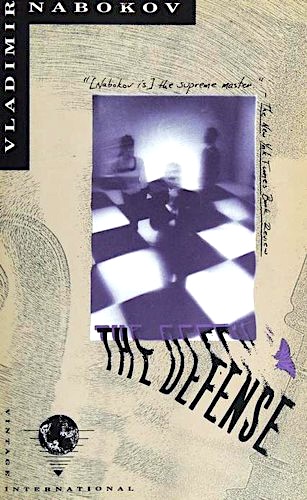📚 Review: The Defense, Nabokov

The Defense, or, The Luzhin Defense, was Vladimir Nabokov’s third novel, published in Russian in 1930 and English in 1962. It is a novel about Luzhin (like, “illusion” – the phonetic allusion is apparently even stronger in Russian), a genius chess master. The story proceeds in 3-acts. In the first act, we see Luzhin as a young child. His world is dull and cruel to him, but he does find chess. In act two, Luzhin has become a chess grandmaster, traveling to compete in tournaments, becoming one of the top players in the world. He meets his wife and mother-in-law. Luzhin is obsessed by the game. Luzhin’s chess obsession starts as an escape in act one, swells in act two, and spills over in act 3. Luzhin adopts chess as reality, this tension between reality and art-reality is the story. I won’t do spoilers in this review, but that tension comes to a relentless, obsessive, monomaniacal head at the very end of the third act.
Like anything Nabokov writes, it is utterly unique. While reading, I identified this novel as a comedy. But it moves, slowly at first, then fast, into a deep tragedy. I didn’t really feel the weight of the tragedy until the very last page. Unlike most tragicomic stories, the tragedy is right out front. But like the game, we don’t see the trap, and walk gaily right into it. Only after the mate is delivered do we realize that we have been outplayed. In this regard, Nabokov is the ultimate virtuoso – his language is so rich and so playful, there is a laugh nearly on every page – we don’t quite realize what he is up to until the final ending blow is delivered.
Glimmers of Pale Fire appear in this novel: the obsession with art, the presence of a singular artistic genius, far above the corporeal world, the separation of the artist from reality, a sort of supra-reality emerging. Transcendence. This seems to be Nabokov’s signature (at least, the one I recognize in the novels of his I’ve read, those being Pale Fire, Invitation to a Beheading, and Lolita). Another of Nabokov’s motifs, the window, is pervasive in this work.
In the preface of my 1990 1st Vintage International Edition, Nabokov describes:
My story was difficult to compose, but I greatly enjoyed taking advantage of this or that image and scene to introduce a fatal pattern into Luzhin’s life and to endow the description of a garden, a journey, a sequence of humdrum events, with the semblance of a game of skill, and, especially in the final chapters, with that of a regular chess attack demolishing the innermost elements of the poor fellow’s sanity.”
The novel is indeed structured this way. Moves are played, the story marches on, the tension between the artist’s abstract world and dull complex reality, white and black, destined only for one end, a supreme triumph of the one over the other. In the third act, of course, the reader is mated.